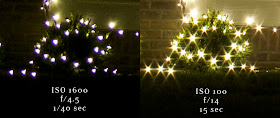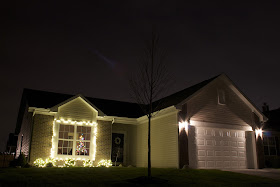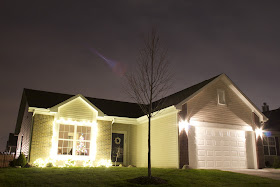1. Use a high f-stop number (narrow aperture) to get pretty lens flares around the lights. This also works with bright stars and planets! Usually when I shoot stars I shoot with a wide aperture to let in the most light (low f-number), but this is not the ideal setting for Christmas lights.
 |
| Very high f-number, very low ISO to reduce noise, and adjust seconds until you have it how you like |
2. You don't have to worry about star trails, so you can use a looooong exposure. I tend to use a wide open aperture for stars to maximize the amount of light I let in as quickly as possible before the stars move, but with Xmas lights this isn't an issue. Keep it narrow and long!
 |
| Variety of camera settings all using ISO 100 |
3. Low ISO to reduce background noise. You have all the time in the world, the house isn't moving, so use super low ISO and longer exposures. Let the individual lights show, or you'll end up with a big bright blob in the bushes.
 |
| ISO 200, 22mm, f/9, 15 sec |
 |
| A little over-cooked! ISO 800, 22mm, f/9, 15 sec |
4. Turn off indoor/window lights and porch lights, let the ambient light show the house. If you are doing a whole house shot, porch lights might drown out the Christmas lights. I prefer to let the glow from the lights reveal the house.
No comments:
Post a Comment